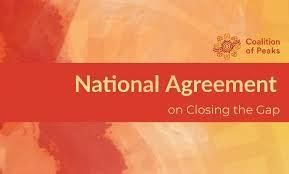
National Agreement on Closing the Gap : at a glance
https://www.closingthegap.gov.au/national-agreement-closing-gap-glance
The objective of the National Agreement on Closing the Gap (the National Agreement) is to enable Aboriginal and Torres Strait Islander people and governments to work together to overcome the inequality experienced by Aboriginal and Torres Strait Islander people, and achieve life outcomes equal to all Australians.
For the first time, the National Agreement has been developed in genuine partnership between Australian governments and the Coalition of Aboriginal and Torres Strait Islander Peak Organisations (the Coalition of Peaks).
The expertise and experience of the Coalition of Peaks and its membership have been central to the commitments in this National Agreement. So too has the feedback from the extensive engagements in 2019 with Aboriginal and Torres Strait Islander people across Australia. A summary of what was heard from the engagements and how it was incorporated into the National Agreement is available.
The views and expertise of Aboriginal and Torres Strait Islander people, including Elders, Traditional Owners and Native Title holders, communities and organisations will continue to provide central guidance to the Coalition of Peaks and Australian governments as the National Agreement is implemented.
The Partnership is grateful for the assistance of the Australian Institute of Health and Welfare (AIHW) and the Australian Bureau of Statistics (ABS) in developing the National Agreement. The AIHW led a number of workshops to assist the Partnership Working Group to consider and develop the target framework, developed trajectories to inform decisions about the level of ambition for different target areas, and provided technical advice on the targets, indicators and data availability. The ABS provided data and technical advice for targets and indicators.
All parties to the National Agreement acknowledged the need for it to be a flexible, “living” document, working with the best evidence as it becomes available.
Priority Reforms
At the centre of the National Agreement are four Priority Reforms that focus on changing the way governments work with Aboriginal and Torres Strait Islander people.
The Priority Reforms will:
- Strengthen and establish formal partnerships and shared decision-making
- Build the Aboriginal and Torres Strait Islander community-controlled sector
- Transform government organisations so they work better for Aboriginal and Torres Strait Islander people
- Improve and share access to data and information to enable Aboriginal and Torres Strait Islander communities make informed decisions.
Outcomes and targets
The National Agreement has 16 targets across the following outcome areas: education, employment, health and wellbeing, justice, safety, housing, land and waters, and languages.
Outcomes are the desired result for Aboriginal and Torres Strait Islander people.
Targets are specific and measurable goals that will be monitored to show how progress is being made across each of the outcome areas. Under each of the targets there are indicators that help to provide an understanding of how progress will be tracked.
The National Agreement includes areas for data development actions. These are areas that are important for our understanding of Aboriginal and Torres Strait Islander outcomes but cannot be measured currently.
Implementing the National Agreement
Each party to the National Agreement will develop their own implementation plan within 12 months of the Agreement coming into effect, and will report annually on their actions to achieve the outcomes of the Agreement.
Implementation plans will be developed and delivered in partnership with Aboriginal and Torres Strait Islander communities and organisations.
Each implementation plan will set out how policies and programs are aligned to the National Agreement and what actions will be taken to achieve the Priority Reforms. They will include information on funding and timeframes for actions.
The Joint Council will review implementation plans and may provide advice on how the parties can better work together to achieve shared outcomes. This includes where progress against the priority reforms and targets is not on track.
Accountability and reporting
The Productivity Commission will publish a dashboard comprising data and associated supporting materials on progress towards the targets. The dashboard will be updated on a regular basis (at a minimum, annually) and will be maintained for the full term of the National Agreement.
In addition to the dashboard, the Productivity Commission will complete a comprehensive, independent review of progress every three years. This review will provide an analysis of progress towards the Priority Reforms, targets, indicators and trajectories. It will also examine the factors contributing to progress by drawing on evaluations and other evidence.
For the first time, there will be Independent Aboriginal and Torres Strait Islander-led reviews within twelve months of each independent review by the Productivity Commission. These reviews are an opportunity to better understand Aboriginal and Torres Strait Islander peoples' experiences of change as a result of this National Agreement.
The Joint Council will provide an annual update on progress toward achieving the National Agreement to the parties to the Agreement.
The Commonwealth, states and territories, local governments and the Coalition of Peaks share accountability for the implementation of the National Agreement and are jointly accountable for the outcomes and targets under the National Agreement.
You can read the article: https://www.theguardian.com/australia-news/2020/jul/29/new-closing-the-g...










Add new comment